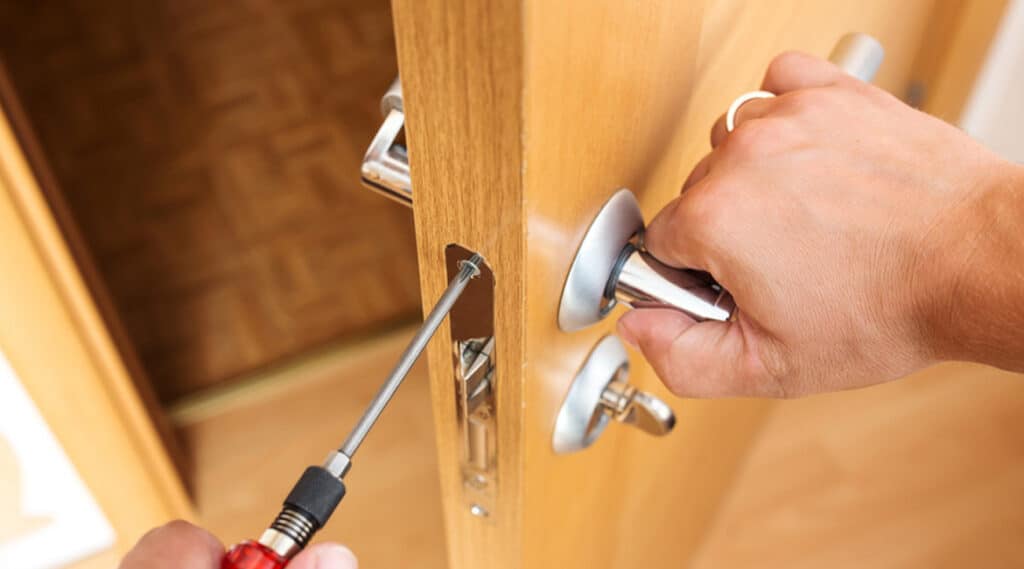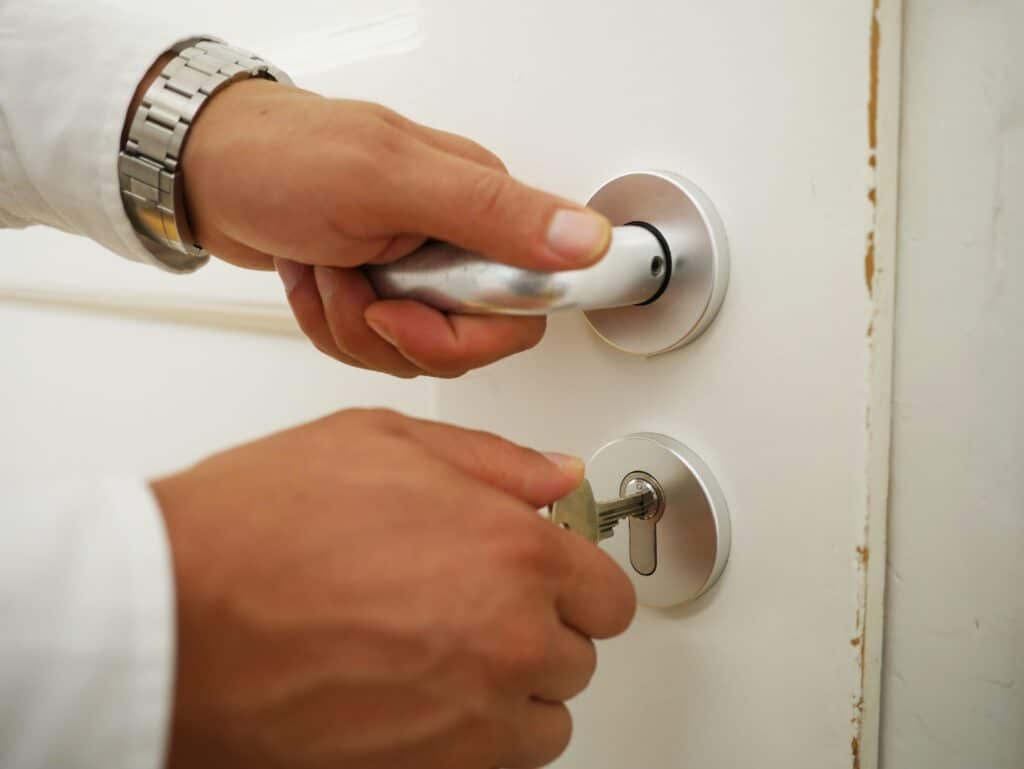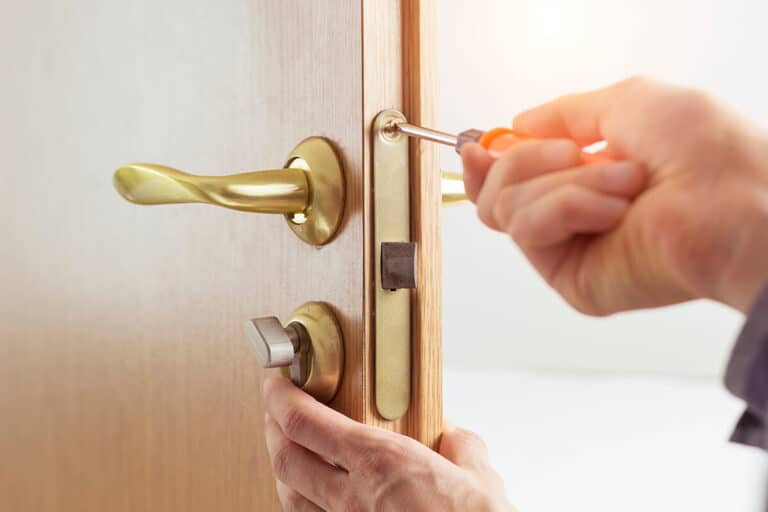Introduction
How To Fix A Loose Door Lock Cylinder: A loose door lock cylinder can be an annoying and potentially security-compromising issue in your home or office. When your door lock cylinder becomes loose, it can lead to difficulty in locking or unlocking the door, which can be a significant inconvenience. However, the good news is that fixing a loose door lock cylinder is a manageable task that you can often tackle on your own, with just a few basic tools and some patience.
To fix a loose door lock cylinder, ensuring your door remains secure and functional. Whether you’re a DIY enthusiast or a homeowner looking to save on repair costs, this guide will provide you with the knowledge and confidence to tackle this common issue effectively. A loose door locked position cylinder can be a frustrating problem that many homeowners encounter at some point. Not only can it make your door difficult to operate, but it can also compromise the security of your property.
Fortunately, you don’t need to be a locksmith to resolve this issue. In this comprehensive guide, we will delve into the reasons behind a loose door lock cylinder and provide you with detailed instructions on how to diagnose the problem, what tools you’ll need, and the steps to take in order to fix it. Whether you’re dealing with a loose lock cylinder on your front door, a bedroom door, or any other entryway, this guide will empower you with the knowledge and skills to restore the functionality and security of your lock. So, let’s get started on the journey to fixing that troublesome loose door lock cylinder.

How do you fix a loose front door lock?
Quick fix: To tighten up a loose lock, line up your door handles on either side of your door and tape the knob in place or have someone temporarily hold it while you work. Once you align the handles, tighten the screws until flush and replace any broken or stripped screws.
Diagnose the Problem
- The first step in fixing a loose front door lock is to identify the root cause of the issue. There can be several reasons for a loose lock, including loose screws, worn-out parts, or dirt and debris inside the lock mechanism. Here’s how to diagnose the problem:
- Inspect the exterior and interior of the door lock for loose screws. Tighten any loose screws using a screwdriver.
- Test the lock by inserting the key and turning it. If the lock still feels loose, proceed to the next step.
Remove the Lock Cylinder
To access the internal components of the lock, you’ll need to remove the lock cylinder. Here’s how to do it:
- Remove the screws on the interior and exterior sides of the door that hold the lock cylinder in place. These screws are typically located on the plate surrounding the lock.
- Carefully slide the lock cylinder out of the door. Be gentle to avoid damaging the lock or door.
Inspect and Clean the Lock
Once you have removed the lock cylinder, inspect it for any visible damage or wear. If you notice any worn-out or damaged parts, you may need to replace them. Otherwise, follow these steps to clean the lock:
- Use a rag or paper towel to wipe away any dirt, dust, or debris from the lock cylinder.
- Use a small brush (like a toothbrush) to clean the internal components of the lock thoroughly.
- Apply a small amount of lubricant (graphite or silicone-based spray) to the moving parts of the lock cylinder. This will help reduce friction and improve the lock’s performance.
Why is my door cylinder not locking?
Door lock problems are often caused by a malfunctioning lock mechanism or latch assembly, but there are several common reasons why locks stop working: The lock is dry or dirty. It doesn’t fit in the door properly. The latch and strike plate don’t align.
A misaligned door or strike plate can prevent the lock bolt from engaging with the strike plate hole correctly. This can occur due to settling of the door frame, shifting of the door itself, or installation issues. To fix misalignment:
Examine the alignment of the door when it is closed. If it doesn’t align with the frame or the strike plate, consider adjusting the hinges or strike plate.
Tighten or reposition the screws on the strike plate to ensure it lines up with the lock bolt.
Worn or Damaged Lock Cylinder
Over time, the components within a lock cylinder can wear out or become damaged. This can result in the lock not functioning correctly. Signs of a worn or damaged lock cylinder include difficulty turning the key, a loose key in the lock, or the inability to lock the door. To address this issue:
Consider replacing the lock cylinder. This is often the most effective solution if the cylinder is significantly worn or damaged.
How do you fix a loose deadbolt lock?
Depending on which screws are at the root of the issue, you may need to remove the thumb turn assembly or other external parts to access and tighten the set screws. Thoroughly check and tighten all screws to realign your deadbolt.
Inspect the interior and exterior of the lock for loose screws. Tighten any loose screws using a screwdriver.
Test the lock by turning the key and the thumb turn to engage and disengage the deadbolt. If it still feels loose, proceed to the next step.
To access the internal components of the deadbolt lock, you’ll need to remove the deadbolt assembly. Follow these steps:
- Remove the screws securing the deadbolt plate on the interior side of the door.
- Carefully slide out the deadbolt assembly from the edge of the door. Be cautious to avoid damaging the lock or door during this process.
Once you’ve removed the deadbolt assembly, inspect it for any visible damage or wear. If you notice any worn-out or damaged parts, consider replacing them. Otherwise, follow these steps to clean the deadbolt:
- Use a rag or paper towel to wipe away any dirt, dust, or debris from the deadbolt components.
- Utilize a small brush (e.g., a toothbrush) to clean the internal parts thoroughly.
Apply a small amount of lubricant (graphite or silicone-based spray) to the moving parts of the deadbolt. This lubrication will reduce friction and enhance the deadbolt’s performance.
Can you fix a door lock?
Whether or not a door lock can be repaired depends on the type of lock. The easiest way when learning how to repair a door lock is to add or remove a hinge packer to one (or all) of the door’s hinges, which will enable the lock to fit into the latch correctly.
Loose Door Lock Cylinder: The lock cylinder can become loose over time, making it difficult to lock or unlock the door.
Keyway Blockage: Dust, dirt, debris, and rust can accumulate inside the keyway, making it hard to insert or turn the key.
Misaligned Door or Strike Plate: A misaligned door or strike plate can prevent the lock bolt from engaging correctly.
Worn or Damaged Lock Cylinder: The internal components of the lock cylinder can wear out or become damaged, resulting in lock issues.
Key Problems: A bent or damaged key can prevent the lock from functioning correctly.
What is best lubricant for door locks?
The best type of lubrication for a lock is a dry lube—such as Teflon (PTFE) or graphite.
Examine the lock components for damage or wear. If you find worn-out or damaged parts, consider replacing them. Clean the lock and its internal components, removing any debris.
Apply a small amount of lubricant (graphite or silicone-based spray) to the moving parts of the lock. This will reduce friction and enhance performance.
Carefully reassemble the lock, ensuring that all components are in their proper places. Reattach screws and plates securely. Test the lock by turning the key or thumb turn to ensure it operates smoothly.
If the problem persists after following the above steps, you may need to consider replacing the lock with a new one, especially if it’s old or severely damaged. Complex security systems or electronic locks may require professional assistance for repair.
Why do I have to lift my door to lock it?
For example, if you have to lift your door to lock it, that could be a sign that your bolt or latch is hitting the bottom of the strike rather than extending fully into it. Use the steps above to adjust the strike. Trouble locking your door can also occur when worn or loose hinges cause your door to sag.
Operate the Lock: Insert the key and turn it several times to work the lubricant into the lock’s internal components. Ensure smooth operation and check for any stiffness or resistance.
Wipe Excess Lubricant: Use a rag or paper towel to wipe away any excess lubricant from the lock and surrounding area. This prevents the accumulation of dirt and dust.
Reapply as Needed: Depending on usage and environmental factors, reapply the lubricant periodically to maintain optimal lock performance.
Prepare the Area: Start by ensuring the lock area is clean and free of dirt or debris. Use a brush or compressed air to remove any loose particles.
Choosing the best lubricant for your door locks and applying it correctly is essential for ensuring smooth operation and prolonging the life of your locks. Consider the type of lubricant that best suits your needs and keep your locks clean and well-maintained. With proper care, your door locks will continue to provide security and convenience for years to come.
What can I use to fix a lock?
The best way to fix a sticky lock that even professional locksmiths choose is lubricating the lock with graphite powder. It is a dry lubricant and, unlike traditional lubricants, allows the locking mechanism to move freely without attracting dirt, grime, and other particles.
Screwdrivers: Both Phillips-head and flat-head screwdrivers are essential for removing and tightening screws in the lock assembly.
Pliers: Pliers can be useful for various tasks, such as extracting a broken key or adjusting internal components.
Lubricants: Graphite-based or silicone-based lubricants can help alleviate stiffness in lock mechanisms.
Replacement Parts: It’s a good idea to keep spare lock parts like screws, strike plates, and lock cylinders handy in case replacements are needed.
Locksmith Tools: Specialized locksmith tools, such as lock pick sets or tension wrenches, may be necessary for more advanced lock repairs.
How do you fix a stick lock?
To fix the problem, the first thing to do is to squirt a small amount of dry lubricant or graphite powder inside the slot where the key goes. Insert the key into the lock and pull it out a few times without turning it.
Loose Lock Cylinder: If your lock cylinder is loose, it may need to be tightened. Use a screwdriver to remove the screws on the lock’s interior and exterior sides. Carefully reposition and tighten the lock cylinder, then reattach the screws.
Sticky Lock: A lock that is difficult to turn can often be resolved with lubrication. Apply a graphite or silicone-based spray into the keyway and operate the lock several times to distribute the lubricant.
Broken Key: When a key breaks off inside the lock, use needle-nose pliers to gently grasp and extract the broken part. Be cautious not to push it further inside.
Misaligned Strike Plate: A strike plate that is not aligned with the lock bolt can cause issues. To fix this, adjust the position of the strike plate on the door frame by loosening its screws and repositioning it.
Worn Lock Mechanism: If internal components of the lock are worn or damaged, they may need to be replaced. Disassemble the lock, remove the damaged parts, and replace them with new ones.

Conclusion
Firstly, it’s important to remember the value of regular maintenance. Just as with any other aspect of your home or office, your door locks require attention and care to ensure they function optimally. By addressing issues like a loose lock cylinder promptly, you can prevent more significant problems down the road and potentially avoid costly repairs or replacements.
Secondly, this DIY project underscores the empowerment that comes with acquiring practical skills. Learning how to fix a loose door lock cylinder not only saves you money but also gives you a sense of accomplishment and self-reliance. It’s a small step towards becoming a more capable and self-sufficient homeowner.
Lastly, this guide highlights the importance of being proactive when it comes to the safety and security of your property. A functioning door lock cylinder is your first line of defense against unwanted intruders, and maintaining it ensures that your home or office remains a safe haven. Regularly inspecting and addressing any lock issues can contribute significantly to your peace of mind.

